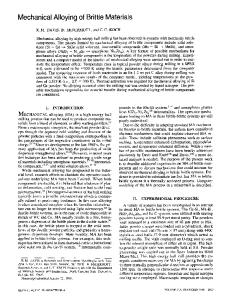The evolution of solutions: A thermodynamic analysis of mechanical alloying
- PDF / 306,787 Bytes
- 6 Pages / 612 x 792 pts (letter) Page_size
- 20 Downloads / 292 Views
I.
INTRODUCTION
CONSIDER the pure components A and B with molar free energies m7A and m7B, respectively. If the components are initially in the form of powders, then the average free energy of mixture of such powders is given by G{mixture} 5 (1 2 x)m7A 1 xm7B
[1]
where x is the mole fraction of B. It is assumed that the powder particles are so large that the A and B atoms do not ‘‘feel’’ each other’s presence via interatomic forces between unlike atoms. It is also assumed that the number of ways in which the mixture of powder particles can be arranged is not sufficiently different from unity to give a significant contribution to a configurational entropy of mixing. Thus, a blend of powders that obeys Eq. [1] is called a mechanical mixture. It has a free energy that is simply a weighted mean of the components, as illustrated by the point u in Figure 1 for a mean composition x. A solution, on the other hand, describes a mixture of atoms or molecules, i.e., the smallest particle in the present context since mixing cannot be achieved on an even finer scale. Generally, there will be an enthalpy change associated with the change in near-neighbor bonds. Because the total number of ways in which the ‘‘particles’’ can arrange is now very large, there will always be a significant contribution from the entropy of mixing. The free energy of the solution is therefore different from that of the mechanical mixture, as illustrated by point v in Figure 1. The difference in the free energy between these two states of the components is the free energy of mixing, the essential term in all thermodynamic models for solutions. In practice, many solutions do not form instantaneously from a mixture of large particles to an intimate mixture of atoms. Instead, the system must go through a series of transition states involving ever decreasing particle sizes and
A.Y. BADMOS, Research Student, and H.K.D.H. BHADESHIA, Reader in Physical Metallurgy, are with the Department of Materials Science and Metallurgy, University of Cambridge, Cambridge CB2 3QZ, United Kingdom. Manuscript submitted May 23, 1997.
METALLURGICAL AND MATERIALS TRANSACTIONS A
increasing number densities as the particles are subdivided. One example is the process of mechanical alloying[1] in which a mixture of large particles is attrited until the subdivision of particles ultimately leads to the formation of a solution. The violent mixing of two initially immiscible liquids is another example. The aim of the work presented here is to study this evolution of such solutions from a purely thermodynamic point of view. It has never been clear as to when the component powders in mechanical alloying become more like a solution than a mechanical mixture. II.
THERMODYNAMIC ANALYSIS
We consider a binary system consisting of pure components A and B. In contrast to the conventional approach for solution theory, the equation for the free energy of mixing must contain particle sizes that can be much greater than an atom. A. Configurational Entropy The change in configurational entrop
Data Loading...











